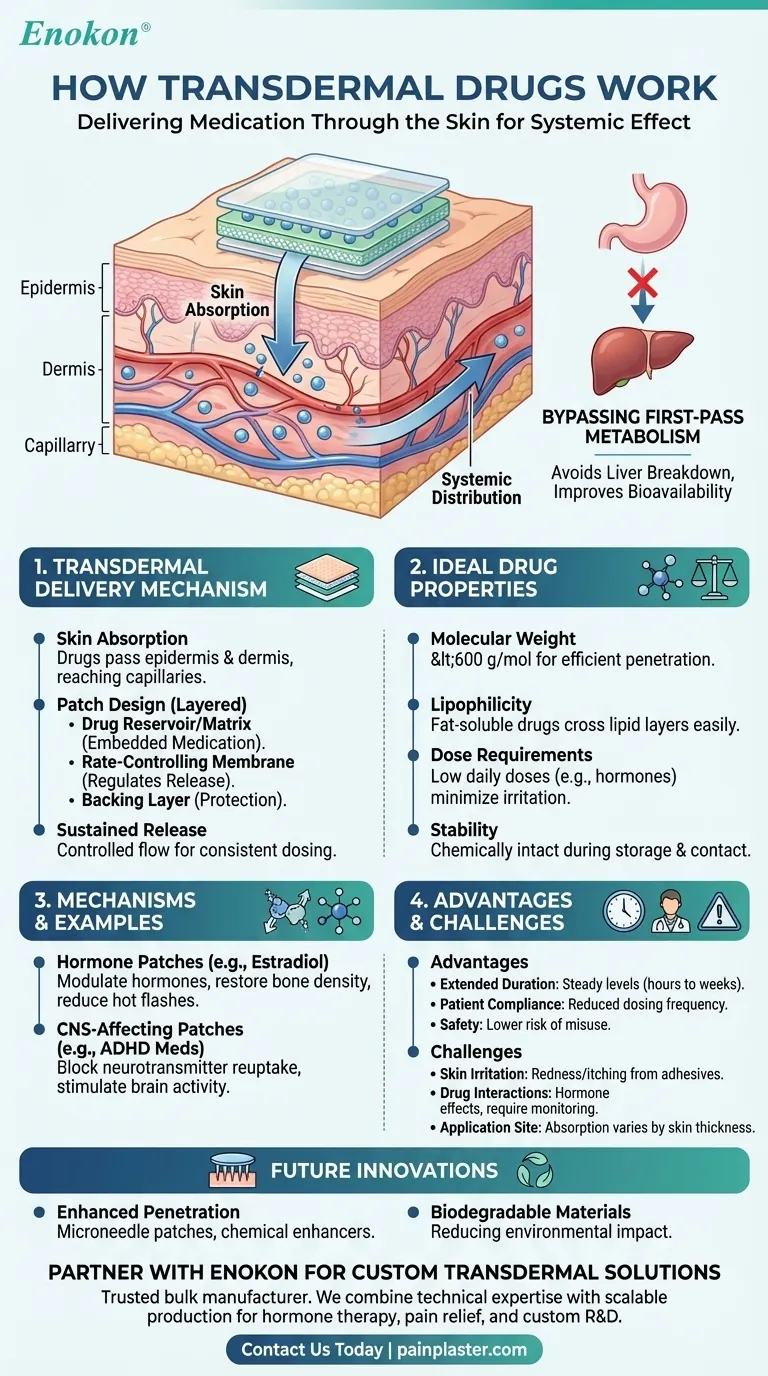Transdermal drugs deliver medication through the skin directly into the bloodstream, offering advantages like sustained release and bypassing gastrointestinal metabolism. These drugs must meet specific criteria (e.g., low molecular weight, skin permeability) to be effective. The mechanism varies by drug type—some modulate hormone levels (e.g., estradiol patches), while others affect neurotransmitter activity. Patches use layered designs to control drug release rates, ensuring consistent dosing. Potential drug interactions require careful monitoring, especially with hormone therapies.

Key Points Explained:
1. How Transdermal Delivery Works
- Skin Absorption: Drugs pass through the epidermis and dermis, reaching capillaries for systemic distribution.
-
Patch Design: Most transdermal patches include:
- A drug reservoir or matrix (e.g., adhesive layer with embedded medication).
- A rate-controlling membrane to regulate release.
- A backing layer to protect against external factors.
- Bypassing First-Pass Metabolism: Avoids liver breakdown, improving bioavailability compared to oral drugs.
2. Ideal Drug Properties
- Molecular Weight: <600 g/mol for efficient skin penetration.
- Lipophilicity: Fat-soluble drugs cross the skin’s lipid-rich outer layer more easily.
- Dose Requirements: Low daily doses (e.g., hormones like estradiol) minimize skin irritation.
- Stability: Must remain chemically intact during storage and skin contact.
3. Mechanisms of Action (Drug-Specific Examples)
-
Hormone Patches (e.g., Estradiol):
- Modulate pituitary hormones (LH/FSH) via negative feedback, alleviating menopause symptoms.
- Restore bone density and reduce hot flashes by replenishing estrogen.
-
CNS-Affecting Patches (e.g., ADHD Medications):
- May block neurotransmitter reuptake (e.g., norepinephrine, dopamine) to stimulate brain activity.
4. Advantages Over Other Delivery Methods
- Extended Duration: Provides steady drug levels for hours to weeks (e.g., nicotine patches).
- Patient Compliance: Reduces dosing frequency (e.g., weekly hormone patches).
- Safety: Lower risk of misuse (e.g., compared to oral opioids).
5. Challenges and Considerations
- Skin Irritation: Adhesives or drug components may cause redness/itching.
- Drug Interactions: Hormone patches can alter effects of other medications (e.g., tamoxifen).
- Application Site: Absorption varies by skin thickness (e.g., upper arm vs. torso).
6. Future Directions
- Enhanced Penetration: Microneedle patches or chemical enhancers to broaden drug options.
- Biodegradable Materials: Reducing environmental impact of patch components.
Transdermal technology exemplifies how subtle engineering—like layered patch designs—can solve biological challenges, making it a cornerstone of modern pain management, hormone therapy, and addiction treatment.
Summary Table:
| Key Aspect | Details |
|---|---|
| Delivery Mechanism | Drugs absorb through skin layers into capillaries for systemic distribution. |
| Ideal Drug Properties | Low molecular weight (<600 g/mol), lipophilic, stable, and low-dose. |
| Advantages | Bypasses liver metabolism, reduces dosing frequency, and minimizes misuse. |
| Challenges | Skin irritation, variable absorption by body site, and drug interactions. |
| Future Innovations | Microneedles and biodegradable materials to expand drug options. |
Partner with Enokon for Custom Transdermal Solutions
As a trusted bulk manufacturer of transdermal patches and pain plasters, we combine technical expertise with scalable production to meet your brand or distribution needs. Whether you require hormone therapy patches, pain relief systems, or custom R&D for innovative formulations, our team ensures precision, compliance, and patient-centric design.
Contact us today to discuss your project and leverage our end-to-end development capabilities!
Visual Guide

Related Products
- Far Infrared Heat Pain Relief Patches Transdermal Patches
- Heating Pain Relief Patches for Menstrual Cramps
- Capsaicin Chili Medicated Pain Relief Patches
- Medical Cooling Gel Patches for Fever Cooling Patches
- Far Infrared Deep Heat Relief Patches Medicated Pain Relief Patches
People Also Ask
- What types of pain can the Deep Heat Pain Relief Back Patch be used for? Targeted Relief for Muscles & Joints
- How do Deep Heat Pain Relief Patches provide pain relief? Discover the Drug-Free Mechanism
- How does capsaicin work in the medicated heat patch? The Science Behind Pain Relief
- How does the Deep Heat Back Patch work? A Drug-Free Solution for Targeted Pain Relief
- Are heat patches safe for all body parts? Key Safety Zones and No-Go Areas Explained












